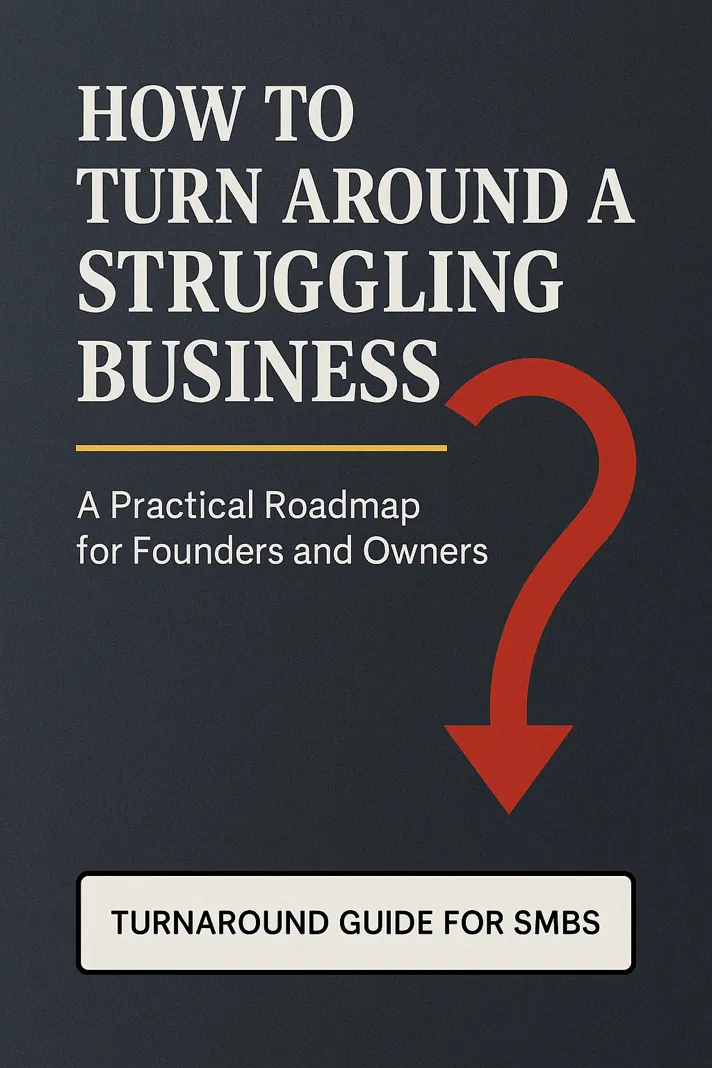
How to Turn Around a Struggling Business: A Practical Roadmap
When a business starts to lose momentum—whether due to declining sales, poor cash flow, high employee turnover, or operational inefficiencies—it can feel like you’re steering a ship through a storm with no compass. But many businesses can be saved, and even thrive, with the right turnaround strategy. Here’s a practical guide to turning around a struggling business, grounded in real-world insights and focused execution.
The first step in any turnaround is honest assessment. Denial is dangerous. Dig into the numbers: cash flow, profit margins, liabilities, debt obligations, customer retention, and employee productivity. If possible, bring in a third-party advisor or interim CFO to give you an objective view.
Questions to ask:
Are we solving a problem people still care about?
What is the real cause of our financial distress?
Which parts of the business are profitable—or at least viable?
Cash is oxygen. Before anything else, extend your runway:
Collect receivables aggressively
Delay non-essential expenses
Renegotiate leases, supplier terms, or debt service
Consider a temporary payment plan with key vendors
Make a 13-week rolling cash forecast to stay on top of liquidity weekly—not monthly.
3. Cut the Fat, Not the Muscle
Layoffs and cost-cutting can be necessary, but the goal is to preserve the core engine of value. Eliminate vanity expenses, underperforming products, and unprofitable marketing campaigns—but double down on the essentials that bring in revenue or retain customers.
Use the “zero-based budgeting” approach: don’t assume anything is sacred.
4. Reconnect with Customers
Many businesses decline because they drift away from their customers’ evolving needs. Re-survey your audience, pick up the phone, read the reviews. What are they buying now? What are their pain points?
You may need to reposition, change pricing models, or simplify your product offering. One strong offer that solves a problem is more powerful than five lukewarm ones.
5. Revitalize the Team
A business in trouble often suffers from poor morale. Be honest with your team about the state of the company—but also paint a path forward.
Ask yourself:
Who are the A-players we must retain?
Is the leadership aligned, or causing confusion?
Can we create a culture of urgency and accountability?
Sometimes, change requires new leadership in key roles.
6. Fix Operational Inefficiencies
Audit your internal processes:
Are we overstaffed in one department and under in another?
Are we using the right technology?
What tasks are being done manually that could be automated?
Small improvements in billing, scheduling, or customer service systems can lead to big wins.
7. Rebuild the Brand and Message
If your messaging no longer resonates, your market won’t respond.
Clarify:
What is our unique value proposition?
Are we communicating it consistently across all channels?
Does our website, marketing, and sales process reflect urgency and trust?
Even a struggling business can reposition itself quickly with a well-targeted message.
8. Bring in Outside Help
Turnaround specialists, fractional executives, or advisory boards can add expertise, perspective, and accountability. A fresh set of eyes helps identify blind spots and make tough calls that founders may avoid.
9. Consider Strategic Capital or M&A
If the business needs more than operational fixes, explore:
Bridge capital from investors who specialize in distressed assets
A merger with a more stable competitor
Selling a portion of the business to unlock cash and partnerships
Done right, outside capital can bring new life—just make sure it aligns with your long-term goals.
10. Execute Relentlessly
The best strategy fails without execution. Create a 90-day turnaround plan with weekly goals, clear KPIs, and ownership. Rally your team, communicate often, and iterate based on results.
Final Thoughts
Turning around a struggling business isn’t easy—but it is possible. Many great companies were once on the brink. With focus, courage, and the right execution, you can move from survival to stability—and eventually, from recovery to growth.
Ready to take the next step?
Your business isn’t finished—it’s just getting started.
